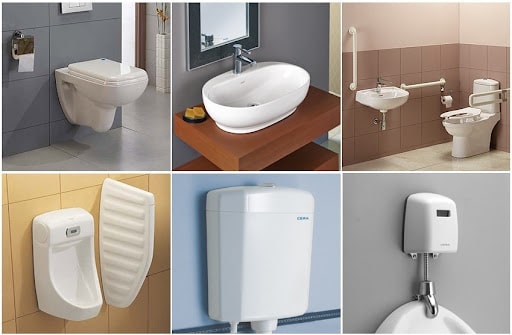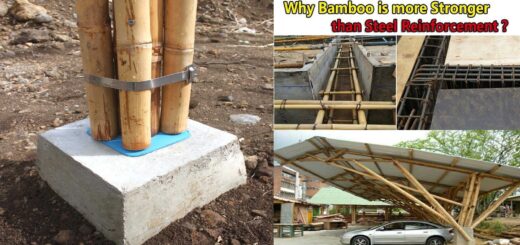Sanitary Fittings: Wash Basin, Sinks, Bathtub & Different Sanitary Fittings

1. Introduction
Sanitary Fittings are used to maintain hygiene in a building, lab, and other places where hygiene is necessary. There are different sanitary fittings available in the market.
2. Sanitary Fittings
The following fittings are commonly used in buildings, for efficient collection and removal of wastewater to the house drain:
(i) Washbasins
(ii) Sinks
(iii) Bathtubs
(iv) Water closets
(v) Urinals
(vi) Flushing cisterns.
2.1. Wash Basin
Washbasins are usually made of pottery or porcelain ware. Sometimes, they are also made of porcelain-enameled cast iron, pressed steel, or plastic, especially where the number of users is more.
An ordinary washbasin is mounted on brackets fixed on the wall, while a pedestal-type basin is mounted on a pedestal rising from the wall. They are available in different shapes and sizes.

Normally, a washbasin is provided with two taps- one for hot water and the other for cold water mounted at its top. It has an oval-shaped bowl, with an overflow slot at the top.
The waste pipe with a metallic strainer is pro-vided at the bottom of the bowl. The waste pipe has a trap at its bottom.
2.2. Sink
While a washbasin is used for washing hands, face, etc. a sink is used in the kitchen or laboratory. These may be made of glazed fire clay, stainless steel, metal, porcelain, or enameled pressed steel. They are manufactured in various sizes and shapes, though the rectangular shape is quite common in kitchens. It may also have a drainboard attached to it.
A sink may also be constructed of cast-in-situ concrete, with suitable finishing surfaces such as marble, terrazzo, etc. The out-let pipe, provided with a grating of brass or nickel, may discharge over a floor trap or nahni trap.
2.3. Bathtub
Bathtubs are usually made of iron or steel coated with enamel, enameled porcelain, or plastic material. They may also be made of cast-in-situ concrete finished with marble chips or terrazzo, or else may Over-be made of marble slabs properly flow jointed at the side.
It has a length varying from 1.7 to 1.85 m, width between 0.7 m to 0.75 m, and depth near waste pipe varying from 0.43 m to 0.45 m. The overall height may vary between 0.58 to 0.6 m. It is provided with outlet and overflow pipes, usually of 40 mm diameter. A trap with a proper water seal is used at the outlet.
2.4. Water closets
Water closets are designed to receive and discharge human excreta directly from the person using them. The appliance is connected to the soil pipe by means of a suitable trap. It is usually connected to a flushing cistern to flush the closet and discharge the human excreta to the soil pipe. Water closets are of three types.
1. Indian type
2. European type
3. Anglo-Indian type.
1. Indian type
The Indian style water closet (W.C.) is simple in construction and working, but is used in squatting positions. It is usually made of porcelain. The pan and trap are available in two different pieces. The trap has an opening for anti siphonage pipe. The W.C. is fixed in a squatting (or sitting) position just at floor level. Since the excreta does not directly fall into the trap, therefore, there are chances for excreta to become foul.
The excreta may stick to the surface of the pan if the flushing is not proper. The flush water enters the rim of the pan through the opening provided in the front of the pan. The flushing cistern is normally kept-2 m above the closet. Indian-type closet requires a greater quantity of water (at least 10 liters) for flushing.
2. European type
It shows a typical European-type water closet. It is usually made of porcelain. It is a wash-down water closet, provide with a seat and a cover. The pan has a flushing rim to spread the flush water The excreta directly falls in the trap, and therefore there are less chances of excreta becoming foul. The pedestal type European W.C. also known as commode is commonly used.
The closet is fitted with either a P-trap or S-trap. It can also be used at the upper floors, while in the case of Indian type WC the upper floor has to be depressed to receive the pan fixed at floor level. Generally, a low-level flushing cistern is used with the European type W.C.
3. Anglo-Indian W.C.
The main advantage of Indian type W.C. is that it can be used in squatting position since i is fixed at floor level, while a European type W.C., which is fixed at about 40 cm higher than the floor level, cannot be conveniently used in squatting position since the legs of the user cannot rest on thin rim conveniently. However, the defect with Indian W.C. is that the excreta it does not fall directly in the An Anglo-Indian W.C. removes both these defects. The closet is fixed about 40 cm above the floor level.
However, the upper rim of the Pan is properly enlarged so that legs can rest on it while used in a squatting position. The inner shape of the pan is intermediate between the two types, with a wider top area of the trap. The excreta directly falls in the water contained by the trap. The top flushing rim and seat etc. are similar to the European type.
Requirements of a water closet
The following are the requirements of a good water closet:
1. It should be convenient in use by persons of all ages both old as well as children,
2. The size of the pan should be such that the urine, as well as the fecal material, does not fall outside the pan.
3. The trap should be such that water does not splash when the excreta falls in the water.
4. Urine should not splash outside the pan.
5. Fecal matter should flow easily in the trap, without sticking to the water. For that, the surface of the pan should be smooth.
6. Flushing should be achieved effectively with the use of a small quantity
7. Fecal material should not be too plainly visible before flushing.
8. The water in the trap should provide an effective and air-tight seal.
9. The pan should be of durable material so that it does not crack with the passage of time.
1.5. Urinals
Urinals are usually of two types :
(i) bowl type and
(ii) slab or stall type
The former type in used in residential buildings while the later type is used in public buildings. A stall urinal normally has more than one unit, with a center to center spacing of 0.6 to 0.7 m. The two types of urinals. The Bowl best types of urinals are made of enameled fire-clay, others of salt-glazed stoneware, marble, slate, and cement.
The contents of urinals are collected and discharged into the soil pipe through the floor trap (nahni trap). Automatic flushing cisterns are generally provided for stall-type urinals, which operates at regular interval of 10 to 15 minutes.
1.6. Flushing cisterns
Flushing cisterns are used for flushing out water closets and urinals. These are made of either cast iron or porcelain. For Indian type WC, cast iron flushing cistern is normally used, fixed at about Over 2 m above the floor level. For Euro flow pear type and Anglo-Indian type closets, porcelain cisterns are normally used, fixed at about 60 cm above floor levels. The low-level flushing cisterns, made of porcelain, are decent in look and operate very easily by simply turning a handle.
Flushing cisterns are of two types
(i) valveless siphonic type and
(ii) valve fitted siphonic type.
Bell-type flushing cistern, commonly used with Indian-type closets, is the typical example of the valveless siphonic cistern. A bell-type flushing cistern consists of the following parts:
1. A bell or dome
2. A float
3. A lever with a chain
4. Inlet, outlet, and overflow pipes and
5. Cast iron casing.
The bell is connected to a flushing chain through a lever. The float is so set that when the discharge level is reached, the float rod closes the inlet cock. When the chain is pulled, the bell is lifted up, thus splashing the water. The splashing of water takes away some air with it, causing a partial vacuum in the top of the bell. Siphonic action thus starts, and water in the cistern enters the bell through holes provided at its bottom.
When the tank is emptied, air enters from the bottom and siphonic action is broken. The lowering of the float results in the opening of the inlet cock, and water thus enters the cistern.
It should be noted that the chain should be released immediately after the pull, otherwise the partial vacuum caused by splashing water may be destroyed by the entry of air from the flush pipe. The capacity of a bell-type flushing cistern may vary between 5 to 15 liters.
Source: dreamcivil.com













Recent Comments